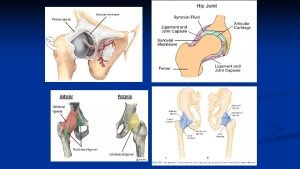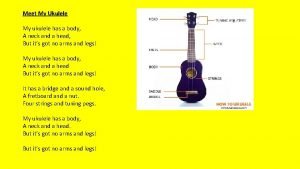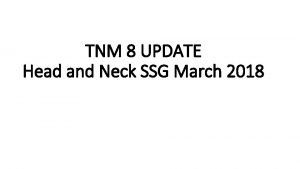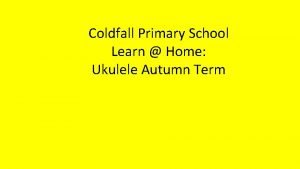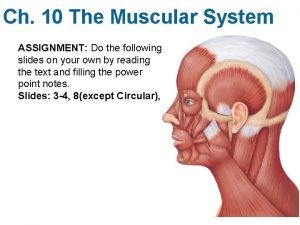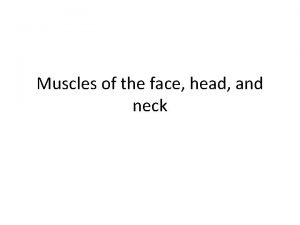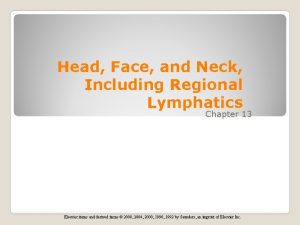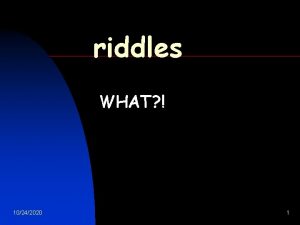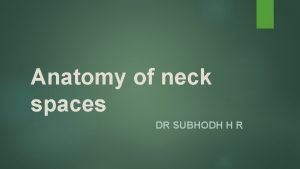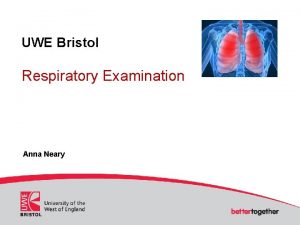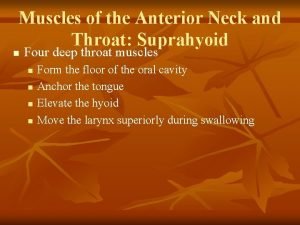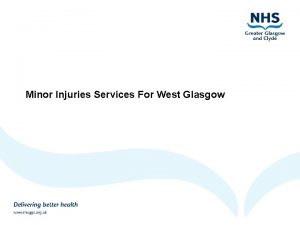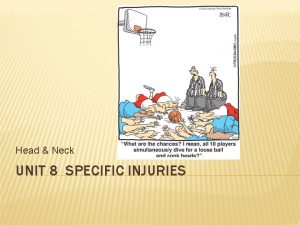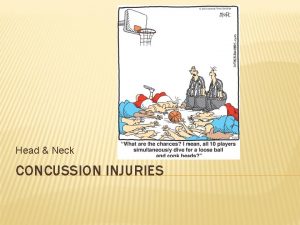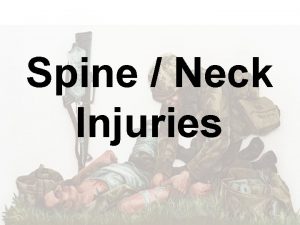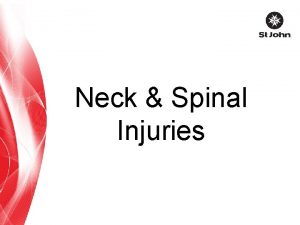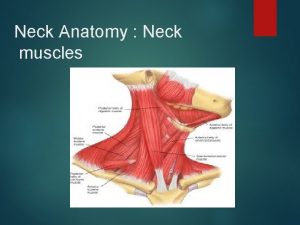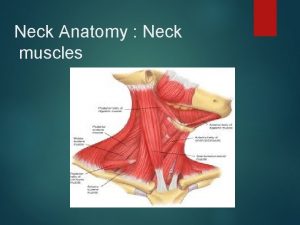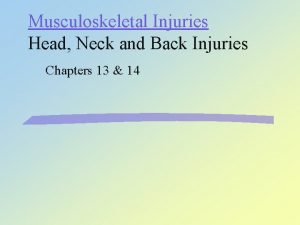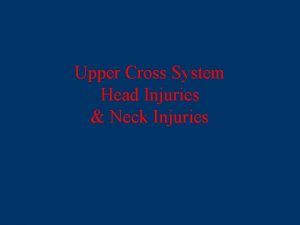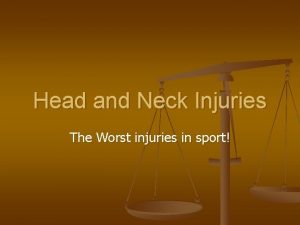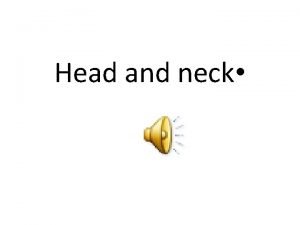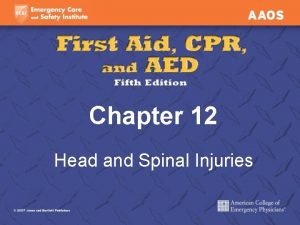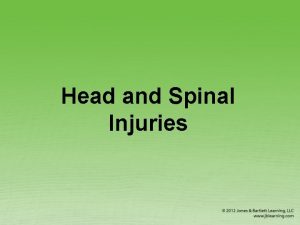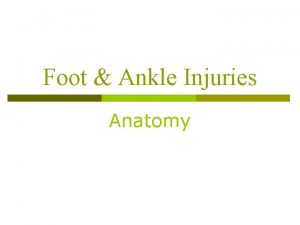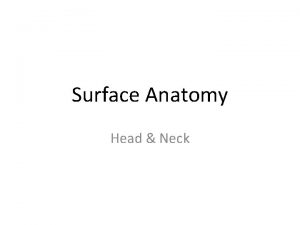Head Neck UNIT 5 1 SPECIFIC INJURIES ANATOMY



















- Slides: 19

Head & Neck UNIT 5. 1 SPECIFIC INJURIES

ANATOMY OF THE HEAD & NECK - BONES Cranium – protects brain. Frontal Parietal (2) Occipital Temporal (2) Facial Mandible Maxille (2) Zygomatic (2) Nasal

ANATOMY OF THE HEAD & NECK - BONES

ANATOMY OF THE HEAD & NECK - BONES Cervical Vertebrae

ANATOMY OF THE HEAD & NECK - MUSCLES Muscle Sternocleidomastoid Trapezius Location Anterior aspect of the neck Posterior aspect of the neck Function Flex neck; rotate the head Extends neck; adducts scapula

ANATOMY OF THE HEAD & NECK – SOFT TISSUES Brain Cerebrum – higher thought processes Cerebellum – balance and coordinated movement Brainstem – vital body functions


ANATOMY OF THE HEAD & NECK – SOFT TISSUES Meninges- layers of tissue that surround brain and spinal cord. Has areas of space between each layer DURA MATER- outer layer made up of arteries and veins SUBDRUAL SPACE ARACHNOID LAYER- spider web of veins SUBARACHNOID SPACE- contains CSF PIA MATER- inner layer lines brain and spinal cord Cerebrospinal Fluid (CSF) - protects, cushions and nourishes the central nervous system.

ANATOMY OF THE HEAD & NECK – SOFT TISSUES

ANATOMY OF THE HEAD & NECK – SOFT TISSUES Intervertebral Disks Cartilagenous discs that lie between the vertebrae. Act as shock absorbers of the spine.

ANATOMY OF THE HEAD & NECK - NERVES Cranial nerves 12 pair that branch off of the brain Spinal Nerves; nerve root pairs that branch off the spinal cord. Brachial Plexus (C 5 -T 1) – bundle of spinal nerves that innervate the shoulder and arm muscles


COMMON INJURIES – HEAD/NECK Concussions Mechanism of Injury Characterized by immediate and transient post-traumatic impairment of neural function Result of direct blow to the head from either a fixed or moving object. Signs of Injury Headache Loss of consciousness Tinnitus Nausea Irritability Confusion Disorientation Dizziness Amnesia Concentration difficulty Photophobia Sleep disturbances Vision disturbances Balance disturbances

COMMON INJURIES – HEAD/NECK Concussions Assessment/Grading: Currently there is debate on whether to or when to grade levels of concussion. Resolution of symptoms should be the focus, rather than the grade of injury.

COMMON INJURIES – HEAD/NECK If it is decided by the health care professional to grade the injury, the following system is recommended: Concussion Grading System – Cantu 2001 Grade I (mild) No loss of consciousness; amnesia lasting less than 30 minutes; other signs/symptoms last less than 24 hours Grade II (moderate) Loss of consciousness less than 1 minute or amnesia lasting more than 30 minutes but less than 24 hours or other signs/symptoms lasting more than 24 hours but less than 7 days Grade III (severe) Loss of consciousness more than 1 minute or amnesia lasting more than 24 hours or other symptoms lasting more than 7 days

COMMON INJURIES – HEAD/NECK Treatment: Careful removal from play Thorough physical and neurological examination Refer to physician for follow-up examination

COMMON INJURIES – HEAD/NECK Return to Play is dependent on the following: Physician recommendation Frequency of concussion Severity of concussion Length of time athlete is asymptomatic Prevention strategies Protective equipment Helmet Mouthguard Proper skill technique Following rules of the sport

COMMON INJURIES – HEAD/NECK Postconcussion Syndrome Persistent symptoms following concussion - May begin immediately following injury and may last for weeks to months Persistent headache Impaired memory Lack of concentration Anxiety Irritability Fatigue Depression Continued visual disturbances Treatment – No clear guidelines Treat symptoms to greatest extent possible Return athlete to play when all signs and symptoms have fully resolved

COMMON INJURIES – HEAD/NECK Second Impact Syndrome Rapid swelling of the brain from additional head trauma; life threatening Second impact could be minor Could be caused by blow to chest that accelerates head. Signs and Symptoms No initial loss of consciousness Rapid worsening leading to: LOC progressing to coma Dilated pupils Loss of eye movement Respiratory failure Treatment: Immediate transport to medical facility Prevention DO NOT LET THIS SITUATION OCCUR! Careful decision making regarding return to play following initial head trauma
 Unit 15:1 providing first aid
Unit 15:1 providing first aid 17:6 providing first aid for burns
17:6 providing first aid for burns A short backboard or vest-style immobilization
A short backboard or vest-style immobilization Chapter 21 caring for head and spine injuries
Chapter 21 caring for head and spine injuries Echomyosis
Echomyosis Thumb brush strum
Thumb brush strum Tnm 8 head and neck
Tnm 8 head and neck Risk factors of head and neck cancer
Risk factors of head and neck cancer My ukulele has a body a neck and a head song
My ukulele has a body a neck and a head song Muscular system assignment
Muscular system assignment Zygomaticus major
Zygomaticus major Regional write up head face and neck
Regional write up head face and neck What has a neck but no head
What has a neck but no head Danger space neck
Danger space neck Mid clavicular line
Mid clavicular line Neck throat anatomy
Neck throat anatomy Musculos
Musculos Stobhill miu
Stobhill miu What is specific weight of water
What is specific weight of water Plummet method specific gravity
Plummet method specific gravity




